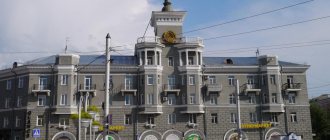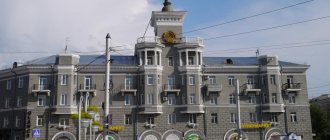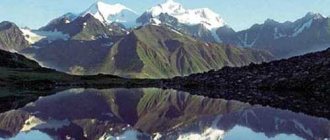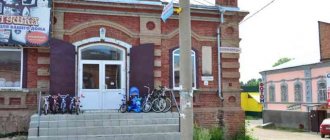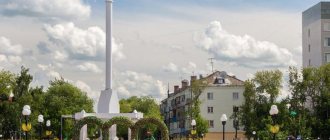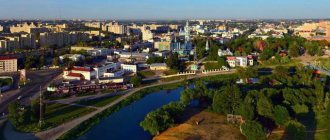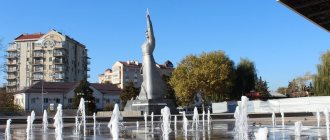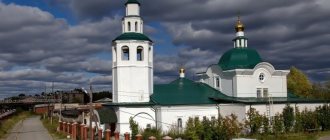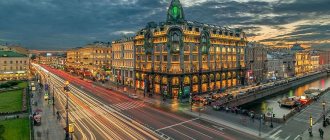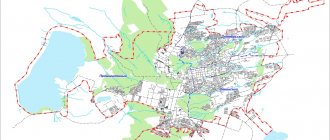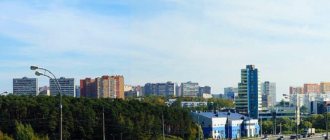From other regions of Russia you can only get to Kamchatka by plane. Flights arriving in this beautiful region land at Elizovo International Airport, Petropavlovsk-Kamchatsky. Flying up to the capital of the region, you can see from above that the city is spread out quite widely on the shore of Avachinskaya Bay, which belongs to the Pacific Ocean. A majestic panorama opens up to your eyes, which will take your breath away: the city surrounded by mountains and water. Very close to Petropavlovsk-Kamchatsky rise the Avachinskaya and Koryakskaya hills, which are active volcanoes.
On the territory of the airport you can see the Li-2 aircraft, turned into a monument. This Soviet military transport ship was actively used in the 40s of the twentieth century, and during the war it worked a lot, transporting cargo. Elizovo was his Kamchatka base.
City population
The indigenous inhabitants of Kamchatka are the Itelmens and Chukchis, but these peoples do not now constitute the majority of the population on the peninsula. People of different nationalities live in Petropavlovsk-Kamchatsky, but most of all Russians. These are the descendants of those who moved here in the 19th century and also came to explore the Far East during Soviet times. In terms of the number of inhabitants, the main city of Kamchatka is not densely populated. It ranks 105th among more than one hundred thousand cities in Russia. At the moment, about 180 thousand people live in the city.
In the 19th century, it was a small village, whose population in different years ranged from 400 to 1,500 people. The development of the city and the growth in the number of its inhabitants occurred during the Soviet period. According to information from 1989, 286 thousand people lived in Petropavlovsk-Kamchatsky, but over the past thirty years this number has decreased by about one hundred thousand. The greatest outflow of people occurred in the crisis years of the 90s. By the beginning of the 21st century, the number of residents of Petropavlovsk-Kamchatsky had stabilized. This is mainly a working-age population; pensioners make up approximately a quarter of the total number of residents. The same is the percentage of people with higher education.
Seasonal rookery of sea lions
In addition to the listed attractions, in Petropavlovsk-Kamchatsky there are five more museums and several Orthodox churches.
The largest Church of the Holy Life-Giving Trinity in the city: The city has several monuments to Lenin, a majestic monument to Saints Peter and Paul, monuments to the T-34 tank and the 3rd battery of Lieutenant Alexander Maksutov.
If there is only a day or two to visit the regional center, tourists do not rush to museums, but go to the seashore. What is it that attracts travelers so much?
On an abandoned pier in Mokhovaya Bay there is a seasonal rookery for sea lions. There are only two places in the world where sea lions live close to people. One is located in the American city of Seattle, the other is here in Petropavlovsk-Kamchatsky.
Steller sea lions settled on the banks of the Avacha about two decades ago. They can be seen from October to April, which is why the rookery is called “seasonal”. If you come to the city at this time, find the opportunity to walk to Mokhovaya Bay. Watch the hulking giants.
Sea animals are allowed to come close, so almost everyone gets great photos. You should not try to feed the sea lions or get close to them. The animals will get scared and dive into the water. Just be there, feel the miracle of this moment. You and the sea lions. An amazing unforgettable combination!
Subscribe to new blog articles, it will be interesting!
Take a walk through interesting places in the city of Sevastopol
Visit the Russian Arctic exhibition at Zaryadye Park in Moscow
Be healthy! Have fun traveling!
History of the city of Petropavlovsk-Kamchatsky
Among the cities of the Far East, Petropavlovsk-Kamchatsky is one of the oldest. The first fort on the site of the future city was founded by Cossack explorers back in 1697. Not far from the Itelmen camp of Aushin, they built storage sheds for yasak and guarded them.
The settlement began to develop on the site of the old fort in 1740. This significant event is associated with the name of navigator Ivan Elagin, who moved on the boat “Holy Archangel Gabriel” from Okhotsk to Kamchatka to explore Avacha Bay in detail. This was necessary in order to draw up a map of it, necessary for navigation. In addition, Elagin was instructed to build houses and warehouses in anticipation of the arrival of the expedition. The navigator did just that.
In mid-June, his boat landed on the shore in Avachinskaya Bay near Aushin, becoming the first ship to arrive here. By autumn, several wooden houses, barracks and barns had already been erected. Elagin reported this to his superiors. Literally a few days later, at the end of September and then at the beginning of October, the ships of the Second Kamchatka Expedition, led by Alexei Chirikov and Vitus Bering, arrived here. Their packet boats bore the names of the holy apostles Peter and Paul, which is why the settlement built by Elagin was called Petropavlovsk.
“St. Apostle Peter”, under the leadership of Bering, arrived here, according to the new style, on October 17, so now this particular date is celebrated as the city’s birthday. The famous Kamchatka explorer Stepan Krasheninnikov, who visited these places around the same time, wrote that “officers’ rooms, barracks, shops and other buildings” were built on the shore of Avachinskaya Bay. That is, the infrastructure of the fort began to develop immediately after the construction of the first houses.
After Bering's expedition, ships did not visit Petropavlovsk for four decades, until two English ships appeared, making the Third Around the World Expedition under the leadership of John Cook. The British liked the bay, as did the presence of a settlement in these parts. Since then, Petropavlovsk has become a must-visit destination for circumnavigation sailors.
The status of the settlement changed in 1912, when the fort became known as the city of Peter and Paul Harbor. It became the only city in Kamchatka, and the residence of the Governor General was located here. This position was first filled by Admiral Vasily Stepanovich Zavoiko, a participant in the Battle of Navarino, who later went on expeditions around the world, explorer of the Pacific coast. A monument was erected to this wonderful man in 2014. In 1849, Peter and Paul Harbor received the status of a regional center. In this capacity, a few years later she showed herself in the Crimean War.
It would seem that there could be a connection between Kamchatka and Crimea, but, nevertheless, there was one. When the Crimean War began, the British and French tried to weaken the enemy by attacking Russia from the east. The English fleet was then recognized as the best in the world, and the French one was equipped with the latest technology; the path to the Far Eastern shores of Russia was already well-trodden, so the governments of Great Britain and France were confident of success.
No serious resistance was expected in Kamchatka. Help from mainland Russia could take months to arrive here. However, the attackers miscalculated. The defenders of Peter and Paul Harbor under the leadership of Zavoiko managed to repel the attack, and the Anglo-French squadron retreated. In memory of the fallen soldiers, a chapel was erected on Nikolskaya Hill. Now Petropavlovsk-Kamchatsky deservedly bears the title of “City of Military Glory”.
Until the mid-twentieth century, the city had no active development. In essence, it was a village with chaotically scattered wooden houses. The base of the Pacific Fleet was located here, ships came here, and Peter and Paul Harbor was not considered in any other capacity. Everything began to change in the 60s of the twentieth century. Petropavlovsk-Kamchatsky (the city began to be called that) began to be actively developed, the population increased, cultural institutions appeared, without which the center of the region is unthinkable.
Historical and cultural monuments
Famous sailors and its heroes contributed to the discovery of the city to the whole world and its development. The sights that decorate Petropavlovsk-Kamchatsky and are included in the program of each excursion are dedicated to them.
The obelisk to Vitus Bering, who wintered here in 1740 during the Second Expedition to Kamchatka, was placed on Sovetskaya Street. It was created with donations from sailors in 1826. The stele rises on a massive granite foundation with a cast-iron slab attached to it with an inscription dedicated to the founder of the city, Bering.
Not far from the Bering stela, a memorial sign in the form of a weighty granite stone surrounded by a chain with an anchor, erected on a white pedestal with the image of a sailing ship in 1882, is directed upward. It is dedicated to the visit to Petropavlovsk in 1787 of the frigates of the outstanding navigator - the Frenchman Jean-François Galot La Perouse.
The monument erected in honor of the English navigator Charles Clarke on the main Lenin Street reminds us of James Cook's expeditions around the world. After the death of James Cook in the last expedition, he led the voyage to Chukotka and, heading there in the spring of 1779, his ships entered the local harbor. Clark died at sea after a failed attempt to break through the ice of the Bering Strait. His ashes are buried under the stone that serves as the base of the monument, erected in 1914 at the request of the British Admiralty Board.
Travelers will remember excursions to Nikolskaya Sopka, where the Maksutov Battery memorial complex was built, named after the lieutenant who commanded the heroic battle with the Anglo-French squadron in 1854. At the end of the 19th century, a pentagonal obelisk of Glory, topped with a golden dome, was erected on the hill. For the centenary of the valiant victory, a memorial architectural ensemble of the necropolis was created with an exquisite chapel, to which a stone staircase leads. There are mass graves on both sides of the chapel. On one side, the dead Russian soldiers are buried, on the other, French and English soldiers are buried. A cannon from 1854 was installed on a tetrahedral pedestal. From there, a narrow concrete path leads to the bay and the isthmus where the “deadly battery” was defended. The sights of the Petropavlovsk-Kamchatsky memorial are guarded by five artillery pieces participating in the defense.
The monument to the apostles Peter and Paul, after whom the city is named, was cast in bronze and installed in October 2005 on the Ozernovskaya Spit during the celebration of the 300th anniversary of Orthodoxy on the peninsula. The height of the sculptural composition of the city’s heavenly patrons is 6 meters. It depicts two first-throne apostles standing on a pedestal near a large Orthodox cross.
The sculpture of St. Nicholas the Wonderworker, the patron saint of fishermen, sailors and traveling wanderers, was installed in December 2008 near Nikolskaya Sopka. The figure of the Saint rises three and a half meters and weighs more than a ton. According to Orthodox canons, St. Nicholas the Wonderworker turns his face towards the east. In his hands is a Holy sword, raised upward and a sculptural model of a temple, symbolizing the Orthodox faith.
Cathedrals and churches
The religious sights of the city are interesting for their rich history and architecture. Notable among them is the easternmost monastery, built in honor of the holy healer Panteleimon on the Communication Hill. The snow-white building, created in the traditions of Russian architecture, is crowned with golden domes. In the monastery church there is a unique shrine - the myrrh-streaming icon of the Mother of God.
At the entrance to Petropavlovsk-Kamchatsky, against the backdrop of the snowy peaks of the Karyaksky and Avachinsky volcanoes, a wonderful view of the landmark opens up - the golden-domed Holy Trinity Cathedral. This is a great opportunity to take amazing photos. The five-domed, two-story cathedral with pieces of the relics of the great martyrs embedded during construction was built in the style of ancient Russian church architecture. It is planned to equip a concert hall on the lower floor of the temple, where spiritual songs and music will be performed.
City infrastructure
Petropavlovsk-Kamchatsky was originally built without any plan, as a place of temporary residence, but its modern structure is not well thought out. When the settlement was small, it made no sense to divide it into districts. After the city grew, two districts were allocated, but this administration was soon abolished. Nowadays, Petropavlovsk-Kamchatsky is divided into several microdistricts. They were created taking into account the natural topography of the city.
The uneven terrain creates certain difficulties, since due to it the city is scattered over a large area, so getting from one area of the city to another can be difficult.
Public transport in the city is represented by buses. All routes lead to the Central District, which is very convenient given the sprawling location of the city. Most city residents have personal transport, but this causes a parking problem. There are few dedicated parking lots, so public spaces that are not intended for parking may be crowded with cars. The condition of the roads is not the best. Due to constant geological activity, even if it is not very pronounced, the asphalt cracks and fails...
The development of tourism dictates its requirements for infrastructure. The need for good hotels, cafes, and restaurants is growing every day. What is offered in Petropavlovsk-Kamchatsky now is of a “normal” level, but there is always something to strive for.
Administrative division
Initially, the small city did not have any division into districts. But during Soviet times, they tried to artificially divide the settlement into three districts. This innovation did not take root, and later the division was cancelled. Today the city consists of microdistricts through which people navigate in space.
The main streets of Petropavlovsk-Kamchatsky are Sovetskaya and Karl Marx Avenue. Many significant objects of the city are grouped around them. But in general, the settlement is very long, which sometimes poses a problem for residents who need to get to some remote places. The population density is 500 people per square meter. km.
Where to go: attractions and interesting places
Petropavlovsk-Kamchatsky cannot boast of significant architectural monuments. The buildings here were built mainly in the 60-80s of the last century, so the capital of the region looks like a Soviet city with standard houses, but in an amazing natural setting. The decoration of the houses has a local flavor associated with the climate. For example, these are metal sheets that are used to cover the walls on the side from which the coldest and strongest wind blows. The wind situation in the city is by no means calm, so such precautions are understandable.
Another feature is the so-called “captain's bridges” in the houses. Due to seismic instability, buildings are equipped with shockproof projections. In residential buildings, such a ledge is designed as a small balcony. Such bay windows, having a purely practical meaning, at the same time play an aesthetic role, decorating houses.
Local museums await residents and guests of the city; they are very interesting and introduce different aspects of Kamchatka life. In addition to the joint and art museums, it will be interesting to visit the museums of the Institute of Volcanology and Seismology, as well as the Scientific Institute of Fisheries and Oceanography. The famous Kamchatka salmon has its own separate museum. There is also a volcano museum called Vulcanarium. This is not a complete list. The city also houses exhibition halls, including the Center for Contemporary Art Loft “Park Kultury”.
When the theater season is open, the evening cultural program can be continued in theaters or at the Philharmonic. Cinemas are open daily.
Unique relief
Kamchatka is the most earthquake-resistant region on the planet. There are about three dozen active volcanoes in the region. Every year, some stone giants wake up and begin to erupt, while others calm down for a while. There are more than three hundred volcanoes in the region. They occupy up to 40% of the peninsula's area.
Due to volcanic formations and mountain ranges, the relief of the Kamchatka Peninsula is heterogeneous. There are no similar places on the map of Russia. From the Sea of Okhotsk, the Western Kamchatka hilly lowland stretches about 60-80 km wide.
Nature of Kamchatka photo:
The Sredinny Range is the largest mountain system in the region, which consists of highly dissected plateaus. Its length is 900 km. There is only one volcano here - Khangar, which was active more than one and a half thousand years ago. In the basin of the Bystraya and Kamchatka rivers, which flow into the Bering Sea, the Central Kamchatka Lowland is located; it stretches for 500 km.
Volcanoes and 70% of the thermal springs of the peninsula are located in the Eastern volcanic zone. It runs along the entire peninsula from north to south and is a turbulent area where eruptions constantly occur.
In 2008, the Koryakskaya Sopka released a powerful smoke plume that reached Petropavlovsk-Kamchatsky. In 2010, the Gorely volcano, which is located 80 km from the capital of the region, awoke. In 2014, the Shiveluch, Zhupanovsky and Karymsky volcanoes showed their character, and in January 2015, Avachinskaya Sopka.
In the peninsula news today:
- The Karymsky volcano threw out a three-kilometer column of ash.
- More than 10 earthquakes occurred off the coast of Kamchatka in one day.
Volcanoes are depicted on the flag and coat of arms of the Kamchatka Territory, as well as the city of Petropavlovsk-Kamchatsky. The volcanoes of the Kamchatka Peninsula are a UNESCO World Heritage Site.
There are specially protected natural areas on the peninsula: three state reserves:
- Kronotsky Reserve
- Commander Reserve
- Koryak Nature Reserve
as well as five natural parks, nature reserves, and natural monuments.
Watch the video:
Economy of the city
There are fishing and fish processing enterprises in Petropavlovsk-Kamchatsky. This is not surprising, since the proximity of the marine resources of the Pacific Ocean naturally contributes to the development of this sector of the national economy. There are both large and many small companies involved in the extraction and processing of fish and seafood. During the salmon spawning period they are especially active.
The port of Petropavlovsk-Kamchatsky has every prospect of becoming an important stronghold of the Northern Sea Route. Nowadays, a wide variety of cargo is transshipped here. There is also a passenger service. A new marine terminal opened in 2022, making it possible for passengers of scheduled ships and cruise ships to have a comfortable stay here.
The city's tourism business is developing well. The beauty of Kamchatka attracts people here who are willing to travel vast distances and spend a lot of money to see amazing places with their own eyes. Travel companies are developing numerous routes so that guests can look into every interesting corner of the peninsula. Various modes of transportation are offered - hiking, car, helicopter tours, on water on boats or boats.
Ski tourism is gaining momentum. Since Petropavlovsk-Kamchatsky is located among the hills, there are ski resorts literally inside the city. In addition, Petropavlovsk-Kamchatsky has international-level ski and biathlon tracks.
Mining companies also make their contribution to the economy of the city and region. Gold, silver and platinum are mined in Kamchatka.
Valley of Geysers
This place was named one of the wonders of Russia by popular vote. The valley is a long volcanic canyon, 4 km wide. More than 40 geysers and hot lakes have already been marked on the map of the reserve. The reserve staff has organized an ecological trail for tourists, traveling along which does not require special equipment. Geothermal springs support a special ecosystem of the canyon, which is represented by lichens and bacteria that lived here many millions of years ago. The biome is supported by unique plants, including the rarest orchid, the Chinese tormentum.
A significant part of the valley is located on the Bolshoi Semyachik volcano, which also remains active. The diameter of its caldera is 15 km, it is open to visitors only a couple of months a year. Travelers are greatly impressed by the Black Lake, in which emissions of steam and dark hot water create a “boiling” effect.
Climate and weather in Petropavlovsk
As throughout Kamchatka, the climate in Petropavlovsk-Kamchatsky was greatly influenced by the Pacific Ocean. Quite mild winters are combined with cool summers. There is practically no heat. The warmest month is August, the average temperature at this time is 13°C. Summer is not rainy. A noticeable wind blows during all seasons.
The geological features of the area suggest seismic activity. Residents of Petropavlovsk-Kamchatsky are ready at any moment for the possibility of an earthquake.
